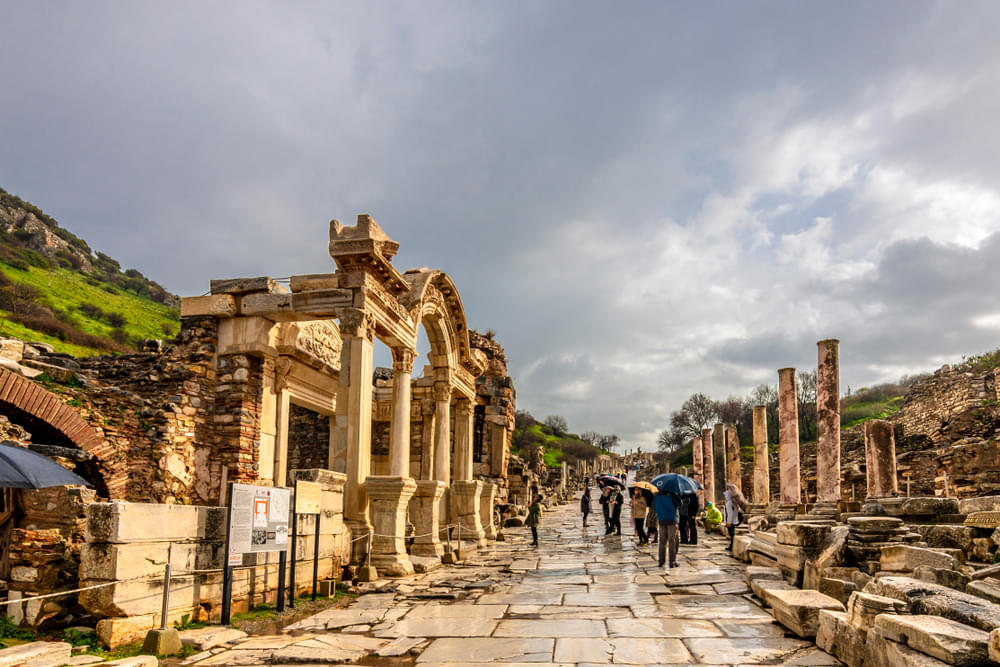About Curetes Street
Curetes Street, one of Ephesus' primary thoroughfares, extends from the Hercules Gate to the Celsus Library. It is the primary pathway that leads to other historical areas of the city. The grandeur of the street and its glorious times can be seen through its marble ruins, intricate facades, fountains, monuments, and temples that run along the way.
This bustling street was once the heart of the city, teeming with merchants, shops, and residences. Additionally, serving as an ancient processional route to the Temple of Artemis, it derives its name from the priests who traversed it during religious observances.
Curetes Street Highlights
• Experience the grandeur of the main thoroughfare of Ephesus, travel back to ancient times, and relive its glory.
• Walk down the street bounded by intricate facades, artistic mosaics as well as galleries of columns that used to lead to different shops and houses of the city.
• Visit the Hadrian Temple, dedicated to the emperor in 129 AD. It is located on the right side of the street.
• Engulf in a picturesque day by taking pictures from the Hercules Gate to the remnants of grand statues and fountains.
• At the end, after strolling through the significant sculptures and monuments, visit the iconic Library of Celsus.
How To Reach Curetes Street
By Air:
Fly from Istanbul to Izmir, then take a 45-minute drive from Izmir Airport to Selcuk. From Selcuk city centre, book a cab and reach Ephesus within 7 to 8 minutes (approx. 3 km).
By Bus:
Take a bus from Istanbul to Selcuk town, but we do not recommend it due to the high prices and long travel time of approximately 9 hours. Once you reach the town of Selcuk, you can book a cab to the Ancient City of Ephesus or take Dolmus (minibus) from the Selcuk City Centre, and reach the site within 7 to 8 minutes (approx. 3 km).
By Ferry:
You can also access Ephesus via ferries departing from Samos, the Greek island. Ferries operate daily between April 1st and October 31st, shuttling back and forth. The ferry fare is approximately 30 Euros including tax for a one-way trip, and 35 Euros including tax for a round trip.
Best Time To Visit Curetes Street
The site of Ephesus is open from 8 AM to 7 PM in the summer season (April to October) and from 8 AM to 5 PM in the winter season.
Best Season to Visit:
The best season to visit Ephesus is spring (April and May) and summer season (September and October). Summers are usually warm during the day, but the spring season is quite pleasant.
Best Time of the Day:
Summers are quite warm in Ephesus, so try to visit the street early morning or early evening. You will avoid mid-day crowds and heat at these times.
Best Day of the Week:
Ephesus is open for longer hours in the summer and also has a tourist rush, the best day to visit can be your personal preference. You can choose a weekday to avoid heavy crowds, but the city seems more flamboyant on weekends.
Curetes Street Other Essential Information
- Planning a summer visit? Remember to pack comfortable sportswear, sunglasses, and sunscreen.
- The walkway is a little slippery on the street. Wear gripping footwear to avoid falling or slipping down.
- To plan an affordable Ephesus trip, pick the spring or autumn season when hotel and tour prices are more reasonable compared to the peak summer season when prices soar due to high demand and limited availability.
- Some vehicles are not available in the city due to its mountain slope foundation. You might have to walk a lot in the street, so people with difficulty in walking should gather all the information before heading there.
Greek Architecture and Art
The facades and sidewalks of Curetes Street are filled with beautiful works of marble and mosaic tiles. Despite being in ruins, this street gives a glimpse into ancient city life. Though mostly damaged, the street remains a relic of the ancient world. Take a guided tour of the street and check out many unique attractions like backgammon boards, statues, and pedestals that were part of everyday life in ancient times.
Temple of Hadrian
One of the most interesting highlights of Ephesus, the Temple of Hadrian was built in honour of the Roman Emperor Hadrian who ruled the city from 117-138 AD. The temple is located on the northern side of Curetes Street, across from Terrace Houses. The architecture is exemplary and was built with Corinthian arches in the prostyle (the columns on the front). The temple depicts the famous figure in Greek culture, Medusa, and its marble columns are still intact which once held the roof of a portico, covering an incredible mosaic sidewalk.
Hallmark of Ephesus – The Hercules Gate
Hercules is the Greek God of strength and holds a high value in Greek culture. At the head of Curetes Street, the Hercules Gate served to halt horse and chariot traffic in the 4th century. Though much of it is gone, fragments are displayed in Domitian Square nearby.
Library of Celsus
Experience the true grandeur of the ancient Roman Empire by visiting the Library of Celsus. It is an architectural marvel and is one of the only remaining instances of great libraries built during the ancient Roman Empire. It was the third largest library in the Greco-Roman world believed to have held around 12000 scrolls.


















.jpg?w=1280&dpr=1)



